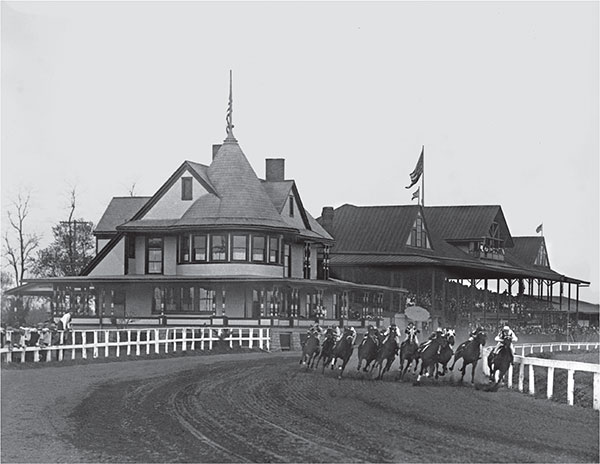
CIVIL WAR RACING IN LEXINGTON
Lexington may hold the distinction of being the only site where racing occurred during the Civil War in Confederate-occupied territory.209
Kentucky officially declared neutrality when the war began, but that posture was untenable as Confederate forces soon invaded far western Kentucky and Union forces moved in from Indiana and Ohio. On September 19, 1861, the Third Kentucky Infantry (USA) marched into Lexington, to be followed the next day by the First Kentucky Cavalry (USA). They camped at the Fairgrounds, now the Student Center portion of the University of Kentucky campus, which included an eight-hundred-seat amphitheater, brick floral hall and a racetrack.210
While the Spring Meet for 1861 appears to have been cancelled, or perhaps begun but abandoned, due to increasing hostilities, the departing of men for one side or the other, etc., races were held in the fall. The Lexington Country Fair held four days of racing starting on September 7 at the Kentucky Association Track on the northeast edge of the city. The Kentucky Association Autumn Meet for six days started on September 23, just four days after the Union army occupied Lexington.211
Lexington was put under martial law, which included denial of the freedoms of speech, press and assembly. Generals ruled the community, and soldiers were posted on street corners. The Union commanders occupied the Bodley House in downtown’s Gratz Park, across the park from the Hunt Morgan house, which belonged to the family of Confederate general John Hunt Morgan. In all, at least twelve regiments camped in Lexington. Despite the occupation, or perhaps because of it, for Union sympathizers, there was an active social season during the winter, with families favoring either side hosting parties and balls.212
Racing continued the next June 2–9 with a full seven days of racing during the Union occupancy.213 However, the forces of the war were moving closer to Lexington.
During August 1862, General Edmund Kirby Smith (CSA) invaded Kentucky through the Cumberland Gap and marched into central Kentucky. On August 30, he defeated a Union force of sixty-five hundred near the city of Richmond. Lexington prepared for the coming Confederate occupation, taking down Union flags and symbols while the retreating Union army destroyed ammunition and supplies.
On September 2, the Confederate force of some eleven thousand men walked into town and paraded down Main Street to the cheers of Southern-leaning citizens.214 General Smith established his headquarters downtown in the Phoenix Hotel.215
Four days later, what was called an “Extra Meeting” was run for three days over the Association track.216 There can be little doubt that General Smith, and particularly his cavalry officers, including General John Hunt Morgan, attended at least some of the races. This was to be the only meet run while the Confederacy controlled Lexington.
After the Battle of Perryville on October 8, the Confederate forces began a retreat to Tennessee. General Morgan and his cavalry fought a rearguard defense to protect the retreating infantry, riding into Lexington for a brief skirmish at Ashland, Henry Clay’s former home, capturing about five hundred men and taking their guns, equipment and horses before leaving to rejoin Smith. Smith’s army took freely of Lexington’s citizens (as had the Northern army earlier), leaving with four thousand wagons, herds of horses, mules and cattle and sheep. Randolph Hollingsworth states that many soldiers carried off country hams affixed to their bayonets.217
Ambrose states that both fall and spring meets were not held in 1863,218 although the Racing Calendars lists a three-day fall meet starting September 21.
The Association Spring Meet of four days was held in May 1864. A week later, the city saw the last war action, as Morgan conducted another raid, among other things burning some stables at the Association track. In addition to liberating all the horses and mules in local livery stables, Morgan stole a number of valuable thoroughbreds from Henry Clay’s son John.219

Kentucky Association Race Track. Lexington History Museum, Inc.
It was generally viewed by those familiar with the cavalry of both sides that thoroughbred horses made the better cavalry mounts, one observer noting that when two units were sent on a hard campaign together, those riding thoroughbreds regularly wore out other breeds.220
The September meet that year was held in regular order for six days; Ambrose reports a large contingent of Union soldiers and officers attended.221
General Robert E. Lee and the Army of Northern Virginia surrendered on April 9, 1865, and the Confederate government fled Richmond, effectively ending the Civil War. Racing in Lexington continued with the Spring Meeting.